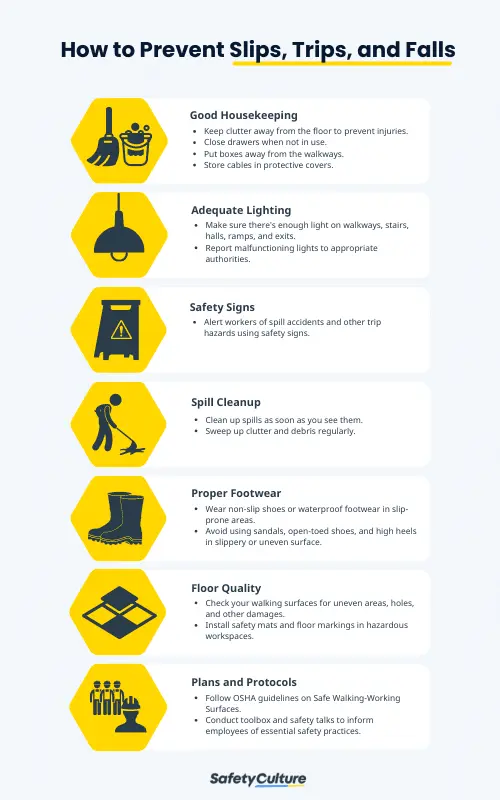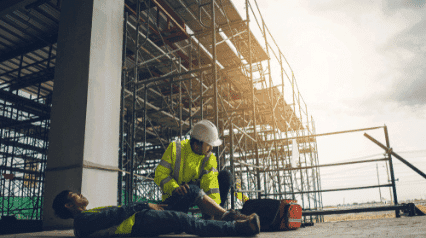What are Slips, Trips, and Falls?
Slips, trips, and falls are among the most common hazards in the workplace. They put many workers at risk of sprains, strains, cuts, bruises, fractures, and other injuries. At worst, they can also lead to death, especially in high-risk occupations such as construction. However, with adequate training and safety practices, companies can keep their personnel safe from these hazards.
For context, slips occur when there’s little to no traction between the footwear and the walking surface, causing a person to lose their balance. On the other hand, tripping happens when a person’s foot hits an object or steps down to a lower, uneven surface. Any of the two can disrupt a person’s balance and make them lose their footing.
Lastly, falls (being the leading cause of fatalities among construction workers) can happen to anyone if they stumble and fall too far off their center balance. This commonly occurs for those working at heights.
Slips, Trips, and Falls in Numbers
The US Bureau of Labor Statistics (BLS) reports alarming rates of slip, trip, and fall incidents in 2022. Their most recent data show that slips, trips, and falls are among the top causes of fatal and non-fatal injuries in the workplace:
- Fatal Injuries – The rate of work-related fatalities caused by slips, trips, and falls was up by 1.8% in 2022 (equating to 865 cases).
- Non-Fatal Injuries – Slips, trips, and falls cases ranked third among the top employer-reported workplace injuries in 2022, involving days away from work.
Common Causes and Risk Factors
Slips, trips, and falls can happen due to many reasons—from uneven working surfaces to unsafe ladder positions. Knowing the causes can help managers assess risk factors and devise ways to prevent them.
Here are the causes and risk factors for each:
Slips
- Wet spills (e.g., water, mud, grease, oil, food, blood, etc.)
- Dry product spills (e.g., powder, dust, wood chips, granules, plastic wraps)
- Weather hazards (e.g., ice, snow)
- Concrete, ceramic tile, or marble floors
- Sloped or uneven walking surfaces
- Wet, muddy, greasy shoes
- Ramps or planks without skid- or slip-resistant surfaces
- Climbing ladders
Trips
- Clutter on the floor
- Obstructed view
- Poor lighting
- Uncovered cables, wires, hoses, and extension cords
- Open drawers, cabinets, doors, etc.
- Uneven walkways
- Unmarked steps or ramps
- Missing floor tiles and bricks
Falls
- Weak or damaged ladders
- Ledges without proper railing
- Carrying heavy objects
- Failure to use guardrails on scaffolding
- Unprotected edges
- Unsafely positioned ladders
- Misused fall protection and height access equipment
Slips, Trips, and Falls Hazards
To give you a comprehensive idea, here’s a list of the most frequently occurring injuries associated with slips, trips, and falls hazards:
- Sprains and strains – When a person slips or trips and tries to catch themselves or regain balance, they may twist or stretch their muscles or ligaments, leading to sprains or strains.
- Fractures and broken bones – Falling from a height or landing forcefully on a hard surface can cause fractures or breaks in bones of the wrists, hips, and ankles.
- Contusions and bruises – Impacts with the ground or objects during a fall can cause contusions, commonly known as bruises, from damaged blood vessels beneath the skin.
- Head injuries – Falls that involve striking the head on a hard surface can cause traumatic brain injuries (TBIs), which can range from mild concussions to more severe cases.
- Cuts and lacerations – Falls may involve contact with sharp or rough objects, leading to cuts and lacerations.
- Back and spinal cord injuries (SCI) – Falls that involve landing on the back or experiencing a jarring impact can cause damage to the spine, such as herniated discs, spinal fractures, or spinal cord injuries.
- Neck injuries – These are sometimes a result of spinal injuries or damage to the muscles, ligaments, or tendons in the neck.
OSHA Regulations
The Occupational Safety and Health Standards 1910 Subpart D (Walking-Working Surfaces) provides general standards for walking-working surfaces, such as passageways, warehouses, storage rooms, service rooms, and working areas.
The 1910.22 Regulations outline several points for safe working surfaces, including the following:
- Keep workroom floors clean, orderly, and dry.
- Provide safe means of entering and exiting from walking surfaces.
- Inspect the working surface to keep it in good condition.
- Repair hazardous floors as soon as possible.
Improve your EHS Management
Cultivate a safe working environment and streamline compliance with our EHS solutions.
Explore now7 Tips for Preventing Slips, Trips, and Falls
Fortunately, most slip, trip, and fall incidents are avoidable. By using the right safety tools and training employees, companies can prevent these incidents from happening. Here are some ways to prevent slips, trips, and falls in the workplace:

How to Prevent Slips Trips and Falls in the Workplace
- Practicing good housekeeping – A slip-free workspace begins with housekeeping. Removing clutter helps tidy up the floor and makes it walkable for everyone in the workplace.
- Providing adequate lighting in walking areas – Workers can navigate through spaces better if there is enough light. Given this, it’s best to place proper lighting in access and egress points such as halls, ramps, stairs, and exits.
- Installing safety signs – Doing so warns people about walking in hazardous spaces to keep them safe. For example, construction safety uses warning lines, control zones, and designated areas to mark which areas are passable or restricted.
- Cleaning spills immediately – Proper cleaning ensures that the floor is free from hazardous elements so that people can walk safely. To keep water from the floor, you may also consider various dewatering methods and equipment such as a sump pump.
- Making sure proper footwear is worn – Non-slip shoes with good traction protect workers from static electricity, falling objects, explosions, exposure to hazardous substances, and other risks.
- Maintaining and improving floor quality – Modifying the floor space can go a long way to ensure safety from slips, trips, and falls. Fall protection can be improved by inspecting floors regularly and investing in non-slippery flooring options, among others.
- Implementing safety plans and protocols – A well-thought-out safety plan cements all efforts in promoting fall protection, especially in high-risk workspaces. This plan must include in-depth risk assessments, safety standards and practices, training, regular inspections, equipment guidelines, and toolbox talks.
Create your Own Safety Management Plan
Build from scratch or choose from our collection of free, ready-to-download, and customizable templates.
Browse Safety Management Plan ChecklistsOSHA provides guidelines on safe working surfaces that companies can integrate into their safety plan (check this table for the distance requirements for fall protection). Also, OSHA includes specifications for safety equipment such as harnesses, lines, safety nets, stair railings, handrails, and Personal Protective Equipment (PPE).
FAQs about Slips, Trips, and Falls
The National Safety Council lists the following industries as those that have the highest risk of slip, trip, and fall incidents:
- Transportation and material moving occupation
- Construction and extraction
- Installation, maintenance, and repair
Employers must keep their workers safe and protected from workplace accidents such as slips, trips, and falls. Aside from that, preventing this workplace hazard is important because it helps avoid negative financial impact, ensure legal and regulatory compliance, increase productivity, enhance business reputation, and improve employee morale and satisfaction.
OSHA’s primary standard for slip, trip, and fall hazards falls under the General Industry Walking-Working Surface standard. Some safety tips emphasized in this standard are to ensure that workers are trained to protect themselves, use the right tools as needed, and equip workers with proper ladders.
While there’s no foolproof way of preventing slips, trips, and falls, organizations can mitigate such incidents by implementing proper safety measures, maintaining a hazard-free environment, and promoting awareness and safe practices among employees.




